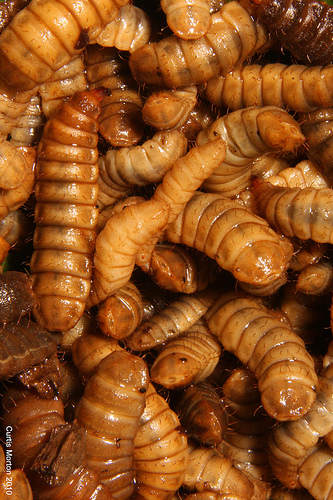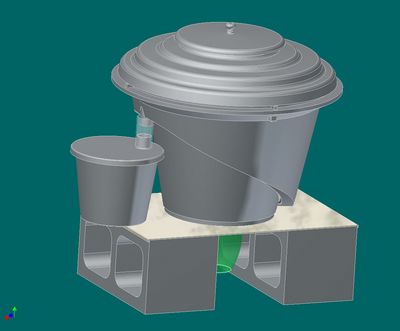Black Soldier Fly: Difference between revisions
No edit summary |
(Removed proprietary technology because there's an equivalent open-source one. Undo if necessary) |
||
| Line 8: | Line 8: | ||
Parts of this text were taken an article by Dr. Paul Olivier - please read [http://blacksoldierflyblog.com/bioconversion-dr_paul_olivier/ the original here]. | Parts of this text were taken an article by Dr. Paul Olivier - please read [http://blacksoldierflyblog.com/bioconversion-dr_paul_olivier/ the original here]. | ||
Larvae of the black soldier fly (BSF), ''Hermetia illucens'', can be used | Larvae of the black soldier fly (BSF), ''Hermetia illucens'', can be used to convert many kinds of organic waste, including putrescent waste such as meat and dairy products. Soldier Grubs are not associated in any way with the transmission of disease. They do not bite, bother or pester humans in any way. In fact, they send out a (pheromonal?) signal to house flies: '''''get lost !''''' | ||
Soldier | ==Applications and Product Ecology== | ||
*Soldier Grubs can be fed to chickens or fish (see: [[Aquaponics|aquaponics]]). They can become an important part of any [[Integrated Food and Waste Management System|integrated food and waste management system]]. | |||
* Oils from Soldier Grubs has been proposed for making diesel - like biofuels and a protein-rich feed additive | |||
* Whatever is left after the Soldier Grubs are done eating can be eaten by worms (vermicomposting), dramatically reducing the weight and volume of the compost | |||
==Open-source Black Soldier Fly composter== | ==Open-source Black Soldier Fly composter== | ||
http://blacksoldierflyblog.com/bsf-bucket-composter-version-2-1/ - An open hardware project to build a composter for Black Soldier Fly. Includes automatic harvesting of the larvae. | http://blacksoldierflyblog.com/bsf-bucket-composter-version-2-1/ - An open hardware project to build a grub composter for Black Soldier Fly. Includes automatic harvesting of the larvae. The grubs abandon the waste only when they have reached their final mature prepupal stage, and they crawl out of the waste and into a collection bucket without any mechanical or human intervention. | ||
The design is for a 5 gallon (19l) bucket that could produce a maximum of 365lb (165kg) of compost a year. | |||
==Further Links== | ==Further Links== | ||
| Line 26: | Line 25: | ||
*[http://en.wikipedia.org/wiki/Hermetia_illucens Wikipedia: Black Soldier Fly] | *[http://en.wikipedia.org/wiki/Hermetia_illucens Wikipedia: Black Soldier Fly] | ||
*[http://www.esrint.com/pages/bioconversion.html ESR International LLC - Dr. Paul Olivier] | *[http://www.esrint.com/pages/bioconversion.html ESR International LLC - Dr. Paul Olivier] | ||
*[http://www.esrla.com/pdf/Brazil.pdf Very detailed information from a project in Brazil (Dr. Paul Olivier) | *[http://www.esrla.com/pdf/Brazil.pdf Very detailed information from a project in Brazil (Dr. Paul Olivier)] | ||
Revision as of 01:55, 6 March 2011
Main > Food and Agriculture > Soil and compost
Parts of this text were taken an article by Dr. Paul Olivier - please read the original here.
Larvae of the black soldier fly (BSF), Hermetia illucens, can be used to convert many kinds of organic waste, including putrescent waste such as meat and dairy products. Soldier Grubs are not associated in any way with the transmission of disease. They do not bite, bother or pester humans in any way. In fact, they send out a (pheromonal?) signal to house flies: get lost !
Applications and Product Ecology
- Soldier Grubs can be fed to chickens or fish (see: aquaponics). They can become an important part of any integrated food and waste management system.
- Oils from Soldier Grubs has been proposed for making diesel - like biofuels and a protein-rich feed additive
- Whatever is left after the Soldier Grubs are done eating can be eaten by worms (vermicomposting), dramatically reducing the weight and volume of the compost
Open-source Black Soldier Fly composter
http://blacksoldierflyblog.com/bsf-bucket-composter-version-2-1/ - An open hardware project to build a grub composter for Black Soldier Fly. Includes automatic harvesting of the larvae. The grubs abandon the waste only when they have reached their final mature prepupal stage, and they crawl out of the waste and into a collection bucket without any mechanical or human intervention.
The design is for a 5 gallon (19l) bucket that could produce a maximum of 365lb (165kg) of compost a year.



